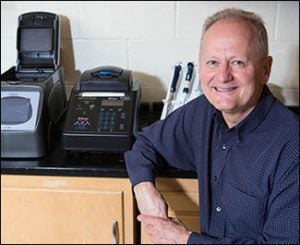‘A REVOLUTIONARY STEP’
Grant funds advanced DNA sequencer for ECU research
Researchers at East Carolina University will soon have the use of an advanced DNA sequencing device that will assist in their studies of genomics, the field of genetics that deals with understanding and analyzing DNA.
Dr. Edmund Stellwag, director of the East Carolina University Genomics Core Facility and Biotechnology Education Program and associate professor of biology, has received a North Carolina Biotechnology Center grant of $149,000 to purchase an Ion Proton DNA sequencer that will benefit collaborators from across the university.

Dr. Edmund Stellwag
About the size of a microwave oven, the Ion Proton System is one of a new generation of instruments that can quickly sequence a large number of DNA bases. For example, the number of DNA bases in the human genome is approximately 3 billion.
The device can determine the sequence of these DNA bases in about a day at a cost of about $1,000; the process took years to complete and cost $2 billion when the human genome was first sequenced, according to the book “The $1,000 Genome: The Revolution in DNA Sequencing and the New Era of Personalized Medicine.”
Deoxyribonucleic acid, or DNA, is a molecule that encodes the genetic instructions used in the development and functioning of all known living organisms and many viruses. DNA sequencing is the process for determining the precise order of nucleotides, or organic molecules, within a DNA molecule. This information is useful in several fields of biology, such as determining how organisms are related and how they evolved and determining how certain genes are associated with diseases and identifying potential drug targets in diseases.
Stellwag said the machine “provides us with the necessary infrastructure to conduct very detailed genetic analysis that cannot be performed using traditional automated DNA sequencers. This capability will help us understand the complex genetic changes that are involved in species evolution, organism function, embryonic development and in genetic and infectious disease.”
According to Stellwag, the equipment’s flexible architecture is adaptable to many applications, such as sequencing a large number of organisms simultaneously, preparing and comparing sequences from different species and sequencing the DNA of species that have never been sequenced before.
Researchers on ECU’s main and health sciences campuses “are sequencing DNA on a daily basis,” said Stellwag. “They are especially interested in using the instrument to study gene expression in diverse organisms and cell types.”
Brett Keiper, an associate professor of biochemistry and molecular biology at the Brody School of Medicine at ECU, will use the device to analyze the genes of a nematode to learn more about how cells divide and become different kinds of tissues and organs. Keiper and other Brody researchers have previously had to contract DNA sequencing to outside vendors at a cost of $8,000 for each experiment.
The new sequencer will cut the cost of each experiment in half, eliminate the paperwork needed to hire a vendor and reduce the time each experiment takes from four months to four-to-six weeks, Keiper said.
Other primary users include the following:
- Baohong Zhang, an associate professor of biology, will use it to study how cotton responds to growth, development and environmental stress to come up with longer, stronger cotton fibers sought by textile makers.
- Keith Keene, an assistant professor of biology, will use it to look into genetic risks that might put African-Americans at higher risk for having multiple strokes. It will help streamline research he’s conducting with a grant from the American Heart Association that could lead to a genetic test for predicting stroke risk.
- Tim Christensen, an associate professor of biology, will use the sequencer to see if the already well-understood genetic information of the fruit fly can help scientists understand more about how the form and shape of genes might cause cancer.
- Kyle Mansfield, an assistant professor of biochemistry and molecular biology, will look at how genes respond to reduced levels of oxygen and sugars. The goal is to come up with new ways to treat diseases such as heart attack and stroke.
“My own research is focused on understanding the gene expression changes that occur during embryonic development,” said Stellwag. “We use high-throughput DNA sequencing to analyze the changes in gene expression that occur during the development of tissue and organs from the fertilized egg through the early stages of embryogenesis. These changes in gene expression provide important information about which genes are important for the specification of each of the developing tissues and organs. They also provide clues concerning developmental defects that arise when these genes are expressed abnormally.”
Most recently, Stellwag’s research has focused on the effects of crude oil exposure on embryonic development. This research seeks to determine whether there are specific developmental defects that arise when embryos are exposed to crude oil during early stages of development.
“The ion proton sequencer is a revolutionary step forward for ECU’s genomics research community,” said Stellwag.
The machine is expected to arrive on campus within a month. Once at ECU, it will be housed in the Genomics Core Facility in the Howell Science Complex, a facility dedicated to DNA molecular analysis instruments. The facility provides genomics analysis resources for the entire ECU campus.
The North Carolina Biotechnology Center is a publicly funded organization that serves the community by providing information, grants, loans and other resources to facilitate the development of biotechnology in North Carolina. More information about the center is online at http://www.ncbiotech.org. Stellwag is also on the center’s Eastern Advisory Committee.
